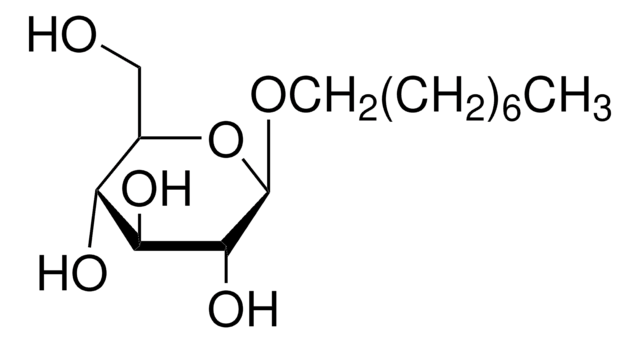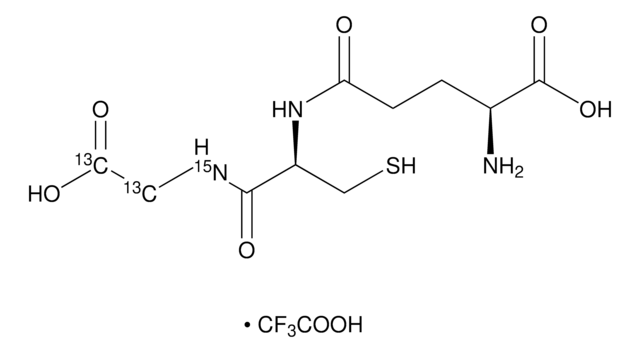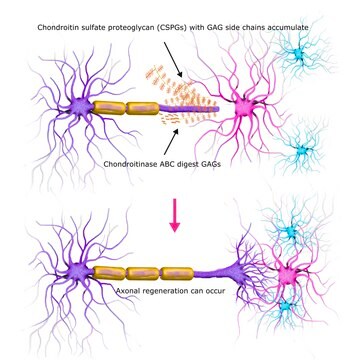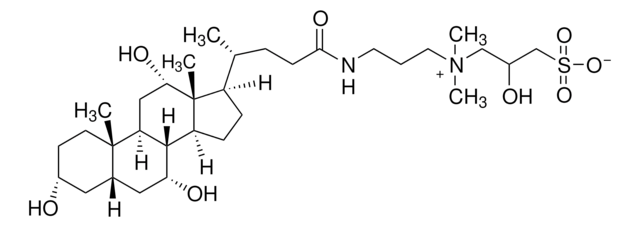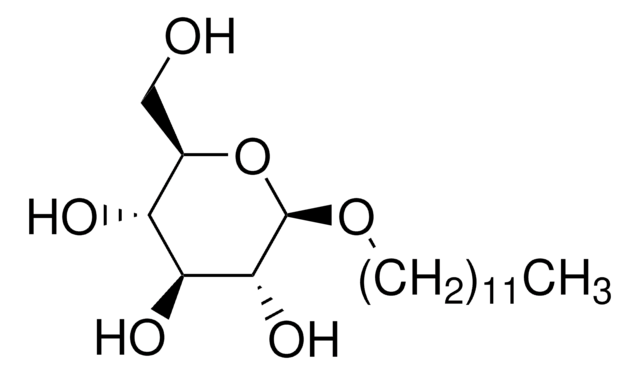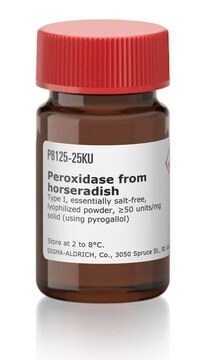O3757
Octyl β-D-glucopyranoside solution
≥95% (HPLC), 50 % (w/v) in H2O
Sinônimo(s):
n-Octyl glucoside, OGP
Faça loginpara ver os preços organizacionais e de contrato
About This Item
Fórmula empírica (Notação de Hill):
C14H28O6
Número CAS:
Peso molecular:
292.37
Número MDL:
Código UNSPSC:
12161902
ID de substância PubChem:
NACRES:
NB.22
Produtos recomendados
descrição
non-ionic
Nível de qualidade
Ensaio
≥95% (HPLC)
peso molecular
average mol wt 24500-25000
concentração
50 % (w/v) in H2O
número de agregação
84
CMC
20-25
temperatura de transição
cloud point ≥100
aplicação(ões)
detection
temperatura de armazenamento
−20°C
cadeia de caracteres SMILES
CCCCCCCCO[C@@H]1O[C@H](CO)[C@@H](O)[C@H](O)[C@H]1O
InChI
1S/C14H28O6/c1-2-3-4-5-6-7-8-19-14-13(18)12(17)11(16)10(9-15)20-14/h10-18H,2-9H2,1H3/t10-,11-,12+,13-,14-/m1/s1
chave InChI
HEGSGKPQLMEBJL-RKQHYHRCSA-N
Categorias relacionadas
Aplicação
2.5% n-octyl β-D glucopyranoside has been used to homogenize mouse retina
n-Octyl β-D-glucopyranoside (OGP) is a non-ionic detergent which has been used for isoelectric focusing (IEF) and two-dimensional electrophoresis (2D). OGP has been shown to be superior to Triton™ X-100 for IEF of plant proteins. n-Octyl β-D-glucopyranoside has also been used for concentration of protein from 2D gels for digestion and mass spectroscopy analysis.
Informações legais
Triton is a trademark of The Dow Chemical Company or an affiliated company of Dow
Código de classe de armazenamento
10 - Combustible liquids
Classe de risco de água (WGK)
WGK 3
Ponto de fulgor (°F)
Not applicable
Ponto de fulgor (°C)
Not applicable
Escolha uma das versões mais recentes:
Já possui este produto?
Encontre a documentação dos produtos que você adquiriu recentemente na biblioteca de documentos.
Os clientes também visualizaram
M F Lopez
Journal of chromatography. B, Biomedical sciences and applications, 722(1-2), 191-202 (1999-03-06)
Two-dimensional electrophoresis has rapidly become the method of choice for resolving complex mixtures of proteins. Since the technique was pioneered in 1975, 2-D gel methods have undergone a series of enhancements to optimize resolution and reproducibility. Recent improvements in the
P J Holloway et al.
Analytical biochemistry, 172(1), 8-15 (1988-07-01)
A technique for the analysis of plant proteins from seed, leaf, root, and coleoptile tissues by high resolution two-dimensional electrophoresis is described. This technique is based primarily on the procedure of P. O'Farrell (1975, J. Biol. Chem. 250, 4007-4021); however
Compartment-specific phosphorylation of phosducin in rods underlies adaptation to various levels of illumination.
Song H, et al.
The Journal of Biological Chemistry (2007)
P Dainese Hatt et al.
European journal of biochemistry, 246(2), 336-343 (1997-06-01)
We have developed a gel electrophoresis system that can concentrate proteins from spots cut out of up to 50 two-dimensional electrophoresis gels. During protein concentration, SDS is substituted with a non-ionic detergent (octyl beta-glucopyranoside) which allows digestion and MS analysis
Christine Ménager et al.
Langmuir : the ACS journal of surfaces and colloids, 26(19), 15453-15463 (2010-09-10)
The present study deals with the morphological modifications of giant dioleoyl phosphatidylcholine vesicles (DOPC GUVs) induced by the nonionic surfactant n-octyl β,D-glucopyranoside at sublytic levels, i.e., in the first steps of the vesicle-to-micelle transition process, when surfactant inserts into the
Nossa equipe de cientistas tem experiência em todas as áreas de pesquisa, incluindo Life Sciences, ciência de materiais, síntese química, cromatografia, química analítica e muitas outras.
Entre em contato com a assistência técnica